Q&A – Ask Neil: June 16, 2022
(Please read these instructions carefully.)
I hope you’re enjoying this new Q&A format. We’re still making minor adjustments, but it’s getting better.
• Click here to post your question.
• After you submit your question, a new window will pop up giving you the address to which you can e-mail a photo to accompany your question. Clear, medium-resolution photos (not thumbnails, please).
• Please only post your question one time.
• One question per reader, please.
• Please use this only for posting questions – not for standard emails.
• Watch for your answer in the following week’s e-gardens.
• I choose those of greatest general interest. For example, plant IDs seldom make the cut.
• I must have your first name or initials.
• I must have your city or county. (Texas is a very large state.)
Before I plunge into this week’s mailbag, I promised Bea from Crockett who called my statewide radio program last Saturday that I would do a little Web searching on her behalf. She said she’d be signing up for e-gardens to see my reply, so here goes…
She asked about a wilt disease that was attacking her sassafras trees. Since I garden in alkaline soils, I told her I have not been successful in growing sassafras in our landscape (although I have tried). Therefore, I needed to do a little more homework.
The University of Kentucky says “Sassafras trees are coming under threat from a new disease, laurel wilt. This disease is caused by a fungus vectored by the Redbay ambrosia beetles. It results in rapid wilting and death of susceptible trees and shrubs. In our area, sassafras is the plant most likely to be impacted by this deadly disease.”
They continue, “Laurel wilt is caused by a fungus, Raffaellea lauricola, that is transmitted to trees and shrubs of the laurel family (Lauraceae) by the wood-boring redbay ambrosia beetle (Xyleborus glabratus). These beetles are considered an invasive species, native to Asia and first detected in Georgia in 2002.”
And, as for managing the problem, they conclude, “Currently, no treatment has been developed that can cure laurel wilt or protect trees from infection. If infected, trees should be cut down and chipped to prevent further spread of these beetles and the fungus. Chips from the infected tree should be destroyed by burning on site or covered with a tarp to prevent spread of the beetles.”
Here is a link to the entire story.
And this from the United States Department of Agriculture.
From North Carolina.
A Master’s degree thesis from Clemson from just last December.
Moving closer to Texas (and Crockett), from the University of Arkansas, along with a map of distribution of the disease as of 6 years ago. It was already close.
From Tennessee.
And, since laurel wilt also is fatal to avocados, a write-up from the USDA Forest Service, Iowa State and the Florida Division of Forestry addresses whether avocados will be next on the list of plants it will attack.
I’m sorry that all of this looks like bad news, Bea. These imported insects and diseases are so disappointing. Good luck!
Question 1
SHUMARD RED OAK IS SPARSE, CRACKED BARK.
Question: We planted this Shumard red oak 5 years ago. It’s had an opening in its trunk for 3 years. We thought it had healed, but now there are small mushrooms. It is not very full of leaves. What can we do? Gracie O., Pflugerville.
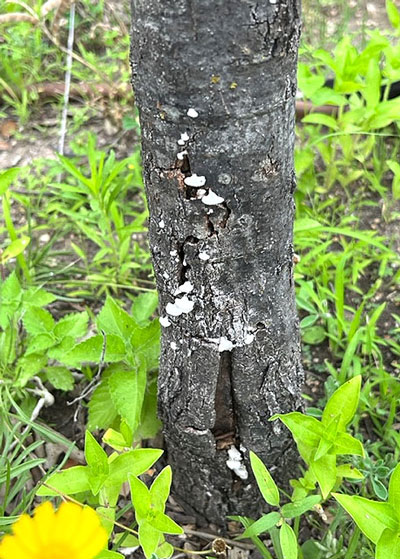
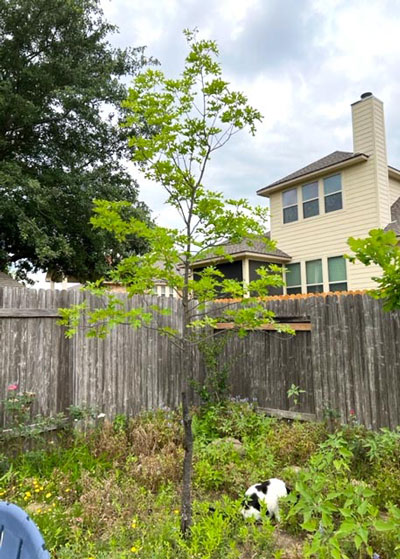
Answer: The source of the problem looks like sunscald. This is very common on young Shumard red oaks because of their very thin bark. The intense west sun will crack the bark and after two or three years it will begin to peel open. That will allow decay to set in. The canopy will begin to thin out and lack proper color and black ooze may flow from the wound. The mushrooms are a natural occurrence. All this is why I always preach that wrapping the trunks of new red oaks, Chinese pistachios, maples and other thin-barked trees is non-negotiable. The wrap should be left in place for two or three years. At this point all you can do is wait to see if the tree can recover. I am worried that it is too far gone. It is too late to wrap the trunk now. Good luck!
Question 2
WHAT TO DO WITH DEAD BRANCHES ON MOUNTAIN LAUREL.
Question: What should I do with these dead branches on my Texas mountain laurel. They did not leaf out after the cold of February 2021. Patricia H., Lott, Falls County.
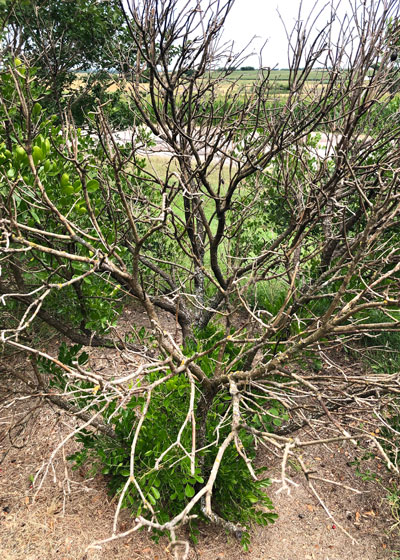
Answer: Prune them off. Trim them flush with the new, vigorous growth that the plant is producing from down below. There is no point in waiting. That advice applies to any other plants any e-gardens readers may have. If branches haven’t leafed out by now, they’re not going to.
Question 3
HOW TO HAVE BOTH PASSIONVINE FLOWERS AND GULF FRITTILARIES.
Question: I planted a passionflower vine for the Gulf Frittilary butterflies. However, they’re stripping it bare. It only blooms at the very beginning of the summer. Is there a way I can have both butterflies and passionflowers? Garrett H., San Antonio.
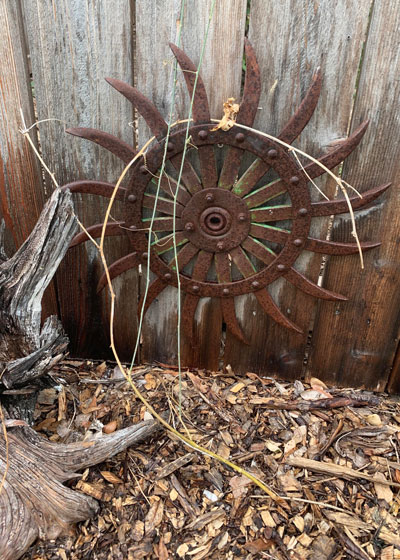
Answer: Wow! Those really have been assaulted! It’s a great question and I don’t know that I have the perfect answer. More vines might be a solution, or perhaps creatively using one of the bird netting products to keep the mama butterflies from laying their eggs on the most visible areas. There aren’t a lot of other host food plants listed on butterfly websites, although they’re fond of lantanas, vitex, verbenas and zinnias for nectar.
QUESTION 4
DOES MULCHING CLIPPINGS REDUCE NUMBER OF FEEDINGS?
Question: I have thick, healthy St. Augustine. I have a mulching mower and I mow my lawn approximately 25 times per year. I feed it three times per year with 15-5-10. Since I am mulching, may I reduce the fertilization frequency or rate? Grady T., Fort Worth.
Answer: Perhaps. You will only know for sure if you have the soil tested every few years. The Texas A&M Soil Testing Laboratory can give you everything you will need to know on their website. Their test will be far more accurate than anything you can do at home. Don’t be surprised if they tell you to apply an all-nitrogen fertilizer with a significant percentage (30-40 percent) of that nitrogen in encapsulated or coated slow-release form. Most Texas soils (except sandy soils) should not be given more phosphorus (middle number of the fertilizer analysis).
QUESTION 5
TOMATOES WILTED SLOWLY.
Question: Last year I lost two tomato plants in maybe 6 weeks. They seemed to wilt slowly and never recovered. This year the same thing is happening, but eight plants have done the same thing. Can you give me information on tomato soil wilt and remedies? Joe E., Gainesville.
Answer: Think about what causes a plant to wilt. It isn’t getting enough water up to its leaves fast enough to meet its demands. Then think about what might cause that to happen. That’s when your list starts to get lengthy. Without more clues and a photo, it would take hours to write it all out. Let me give you a few possibilities.
• Soils that remain too wet for several days. That may or may not be your case, but it’s why we always want to grow tomatoes in raised beds. They don’t tolerate waterlogged soils following heavy rains at all well.
• Sudden change from cool, cloudy weather to very hot, sunny conditions. I know we’ve been very warm/hot for what seems like a long time, but we did have a couple of abrupt transitions over the past month.
• Nematodes. These are microscopic, soil-borne worms that sting the roots and feed off the plant “juices.” They often lead to knot-like galls developing on the roots. When you remove these plants examine their root systems carefully.
There are other things that cause wilting of tomatoes, some of them pathologic. I’ll give you links to a few university sites.
From the University of Georgia.
Closer to home, from Oklahoma State. (Note that they say this one shows up rapidly, not over a period of several weeks.)
And, from Clemson. (Where they also agree that this one works quickly.)
And the University of Maryland.
Here is a very useful page from Texas A&M that includes not only wilts but other tomato leaf disorders to help you identify the source of troubles.
One thing I’m going to suggest is that you not replant in this same location for several years. Move your tomatoes, peppers, eggplants and other plants from the Nightshade Family elsewhere in case there might be some soil-borne problem. Of course, this could be an above-ground problem like early blight or even spider mites. Again, a photo would certainly have been helpful.
At this point I’m going to need to move on to others’ questions. If you choose to Google anything further, I would suggest using the key word “university” at the front end of any search you conduct. That gives you the benefit of real research scientists. Good luck!
QUESTION 6
HYDROGEN PEROXIDE AS AN INSECTICIDE ON TOMATOES?
Question: I have seen a lot about using diluted hydrogen peroxide to control insects on tomatoes. Is it safe to use? Suzanne T., College Station.
Answer: I grew up watching my dad do product label research for the Texas Agricultural Experiment Station of Texas A&M. I learned at an early age to refer people to products’ labels for information on application rates, safety precautions and remedies should problems arise, so I will do just that. Read and follow label directions. (I suspect you will find no reference to the use of hydrogen peroxide on any product label. That alone should give you a big message.)
I just spent 15 minutes doing Web searches for “university hydrogen peroxide tomato insects” and came up with no matches. The liability risks are far too great for me to start recommending products that aren’t legally labeled, especially for food crops, so I’m out.
QUESTION 7
CHINESE PISTACHIO IN THE HILL COUNTRY HAS YELLOWED.
Question: My Chinese pistachio is always yellow, I presume from iron chlorosis. This year two branches are developing dark spots on their leaves. What can I do? Ray T., Fredericksburg.
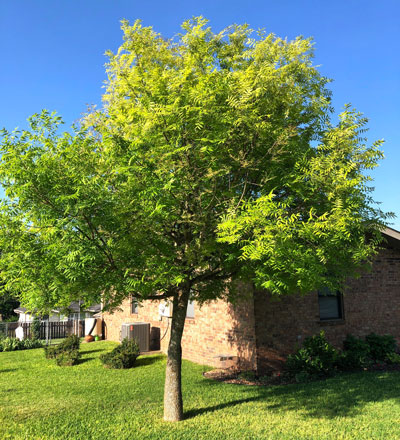
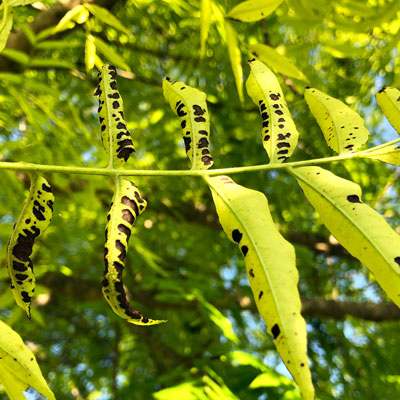
Answer: You are correct. This is iron deficiency brought on by your alkaline soil. Try adding a combination product containing iron and sulfur (sulfur to lower the pH and, in doing so, to help keep the iron in a soluble form). Do so monthly for the next couple of years, April through September. Keep all iron products off masonry surfaces since iron stains.
You might also hire a certified arborist to inject iron directly into the tree’s trunk. That would give you a quick read on whether iron was going to help. That would bypass the root system and the alkaline soil.
The only problem in all of this is that as the tree grows larger it will need more and more iron, so you’re very likely have to keep doing this year after year. That’s a decision you’ll have to make.
By the way, the iron may also help your St. Augustine. It also looks like it is suffering chlorosis. If its blades are striped yellow and green that would be the case.
QUESTION 8
MUNCHKIN OAKLEAF HYDRANGEA IS STRUGGLING.
Question: My 2-year-old Munchkin oakleaf hydrangea began to wilt. The bottom leaves dried up and a white growth developed on the leaves. A companion plant 3 feet away looks fine. What is wrong? Marilyn B., Garland.
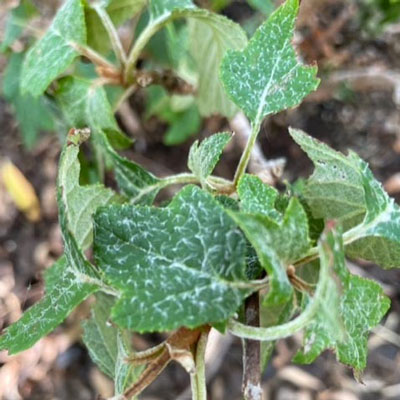
Answer: Honestly, the plant in your photo doesn’t look very bad. The white spots on the leaves look to my eye more like mineral deposits than anything more serious. That would happen when water dries on the foliage. I zoomed in as best I could and I don’t think it’s powdery mildew. I have 12 or 15 oakleafs and I’ve never seen them bothered by it. My best guess from this one photo and your description would be that the plant might have gotten too dry one or more times. They consume a great deal of water for each individual plant. In my final proofing I do wonder if the leaves might be a bit curled. You haven’t used a broadleafed weedkiller anywhere in your landscape, have you? Or a sprayer that once contained one?
QUESTION 9
LIVE OAK IS SENDING UP SUCKERS NON-STOP.
Question: My live oak is sending up suckers continuously and the one on the other side of the yard has raised knobs. What’s going on? Sharon B., McKinney.

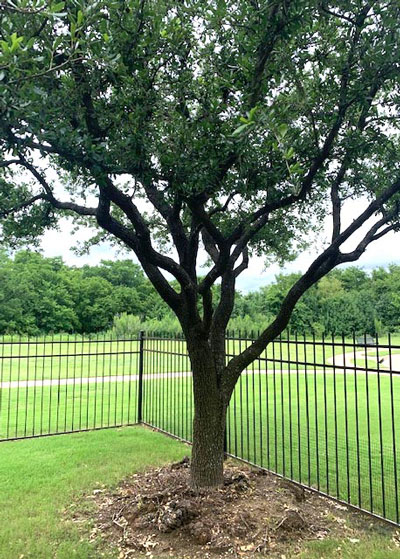
Answer: You have the two blemishes for which live oaks are known. About 15 percent of the ones I have observed during my long career have the genetic issue of sending up root sprouts. Since they’re tethered to mama you can’t spray to kill them. All you can do is dig them by hand or put some kind of barrier over them so they will be blocked. Unfortunately, they are very strong and can push up through most types of weed-blocking materials. But you might experiment with a few on small parts of the root system. You can camouflage that they are there with decorative stone.
As for the “knobs,” those are surface roots. They are very normal. Whoever planted the live oaks may not have dug the holes quite deep enough. I’m judging from (a) the fact that these surface roots developed at such a young age of this tree and (b) the fact that they piled so much soil up around the trunks of both trees (a very harmful practice). That soil needs to be pulled back to expose the root flares of the trees.
QUESTION 10
CONTROL LACY WEED IN BERMUDA LAWN.
Question: How can we control a lacy-looking weed in our bermuda lawn? It looks like old-fashioned Queen Anne’s lace, but it has a big root. Ellen R., Fort Worth.
Answer: Any non-grassy plant like you are describing would fall into the category of a “broadleafed” weed. Broadleafed herbicides containing 2,4-D and usually two other active ingredients will eliminate the weeds very efficiently with just one or two sprayings. Read and follow the label directions carefully for best results. These sprays are not to be used on St. Augustine lawns during the hot weather of summer. In all honesty, you may get better results by stepping up your feeding, watering and mowing practices. Your grass should be able to crowd the weed out.
QUESTION 11
WHAT WILL COMBAT EROSION IN SHADE?
Question: Grass won’t grow in this area between our houses. Drainage and lack of sunlight are the main problems. What can I plant here to combat erosion? Danielle K., Little Elm.
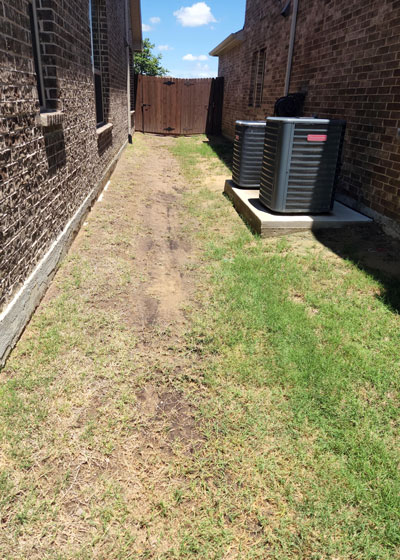
Answer: I have several areas that are essentially like that in our landscape. You have the perfect place for a groundcover, and the two that I would suggest would be purple wintercreeper euonymus and mondograss (monkeygrass). Of the two, I would lean toward the mondograss. It produces no runners, so it’s very easy to blow leaves and other debris out of it. It will never need to be trimmed, and it holds soil tenaciously. You can also walk on it occasionally, for example, to service the HVAC equipment. Prepare the soil carefully by adding a couple of inches of organic matter as you rototill the planting bed. Space fist-sized clumps of mondograss on 8- or 9-inch centers and keep the area watered well. It should be covered completely by this time next year.
QUESTION 12
COULD GLYPHOSATE ELIMINATE BASKETGRASS IN ST. AUGUSTINE?
Question: Basketgrass is outgrowing our St. Augustine. I know that glyphosates are non-selective when it comes to killing grasses. Is there any chance an ultra-diluted solution of glyphosate might knock down the bristle basketgrass while leaving the St. Augustine relatively unharmed? Jim B., Missouri City.

Answer: Oh, goodness. I can’t recommend that you do that since it’s not on the label, but I’ve just spent 30 minutes reading up on this newcomer weed. It’s a really big challenge, and the fact that it’s in St. Augustine makes it all the worse since St. Augustine is so touchy. What I would do myself is try a small area (a few square feet) out of sight in the backyard. I might wait until early fall if at all possible, until temperatures break just a bit. I would use a tank sprayer so I could be very precise in my amounts applied and how I applied it. I would start with an extremely diluted amount. But you also have to hope that it will be strong enough to kill the basketgrass, and you would have to follow that up with a diligent program of pre-emergent weedkiller applications. I have not fought this weed firsthand, so I’m having to learn along with you. It doesn’t sound like fun. I didn’t find much help from university websites.
QUESTION 13
CONTROLLING POISON IVY IN MINT BED.
Question: We have a spearmint garden that has thrived, but we have poison ivy in one of the beds. If we kill the poison ivy will the mint be safe to consume? Corinne S., Plano.
Answer: Yes, if it shows no effects from the weedkiller. You’re going to have to be very precise in how you apply the herbicide, however, to keep it off the mint.
QUESTION 14
HOW TO CONTROL POKE SALAD.
Question: My backyard has been overrun by what is called “poke salat” or “poke salad.” It is in beds and in the lawn. How can I control it? Jana G., Jefferson.
Answer: Birds have probably planted it for you. They love the fruit as it ripens. Actually, visually, so do I. It’s a striking landscape plant. I try to leave one or two in my own garden. It’s easily removed with a sharp hoe dragged across the seedlings as they start growing. Mowing will eliminate them in the lawn. I guess you could use a broadleafed weedkiller spray, but I can’t feature doing that for this specific weed. It’s just too easy to remove manually with a hoe. You don’t even have to chop unless you let it get out of hand.
